Spirea in Siberia: planting and care
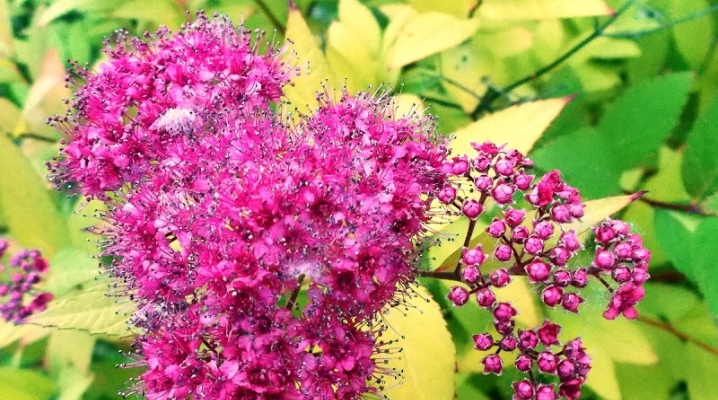
Many gardeners, choosing a perennial flowering shrub for their site, prefer spirea. Given the climatic features of Siberia, spiraea is an excellent option for decorating a garden, since this shrub with lush and bright flowers is also quite frost-resistant.
Spirea is unpretentious to care for, which makes it attractive even for fairly inexperienced gardeners.

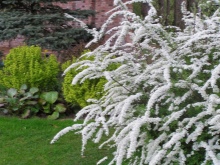
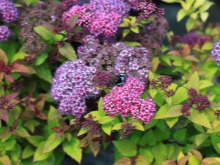
Variety selection
Spirea has a rich variety of varieties. They can be conditionally divided according to their growth into tall and short ones, according to the shape of the crown - into spherical, cascade-shaped and erect shapes, according to the color of the flowers - with white inflorescences and with pink ones. It is generally accepted to divide varieties into spring-flowering and summer-flowering plants.
In spring-flowering crops, white buds are formed on last year's shoots and bloom for a short time. In summer-flowering varieties, the inflorescences can have a variety of shades of pink and are formed on the shoots of this year. Summer flowering crops have a longer flowering time, in some cases they can bloom throughout the summer season.
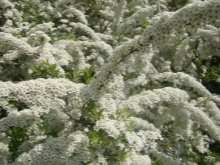
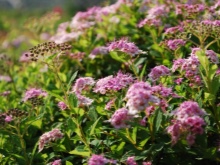
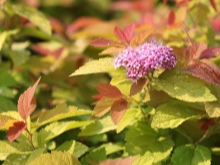
The most common varieties of spirea for growing in Siberia are as follows.
- Greifshame. The most popular type of spring-flowering spirea. It is a sprawling shrub, about 2 meters high, with lush inflorescences of small gray flowers. After planting, it begins to bloom in the second year. The flowering season is in mid-May and lasts for about a month and a half. This variety is a hybrid and does not form seeds, therefore it must be planted vegetatively.
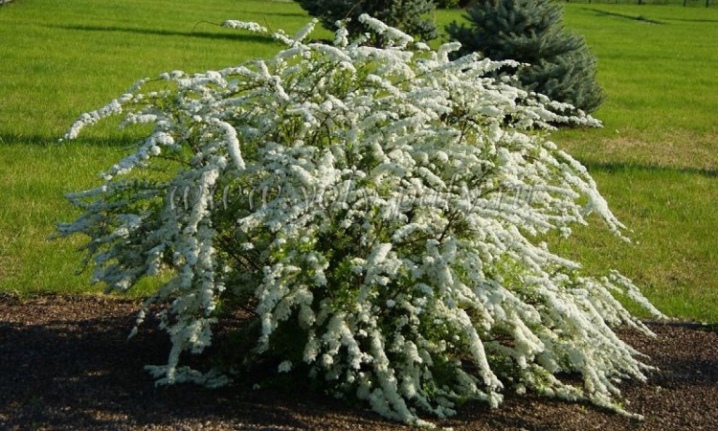
- "Wangutta". This variety is also hybrid and has high winter hardiness. An adult shrub reaches 2 meters in width and height, has a spherical crown. It is one of the few varieties that can bloom in early and late summer. Small flowers are collected in globular umbellate inflorescences.
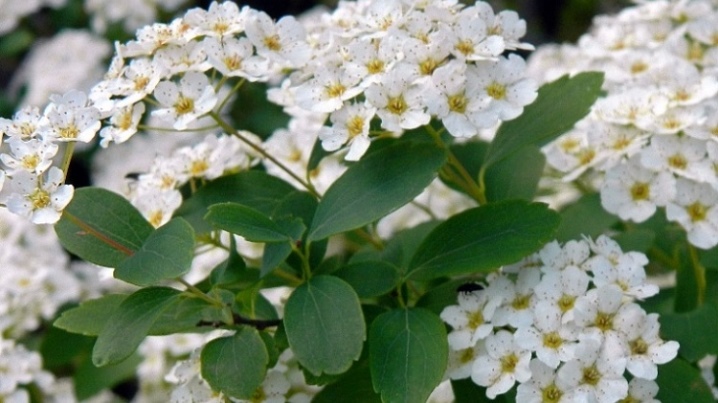
- "Ivolistnaya". A type of spirea with erect shoots of red-brown color, reaching 2 meters in height. Flowers are collected in panicle inflorescences and can be either white or pink. Willow spirea tolerates frost well and is unpretentious in care. In the wild, it most often grows along the banks of water bodies.
The peculiarity of this species is in the leaf plates whitish on top.
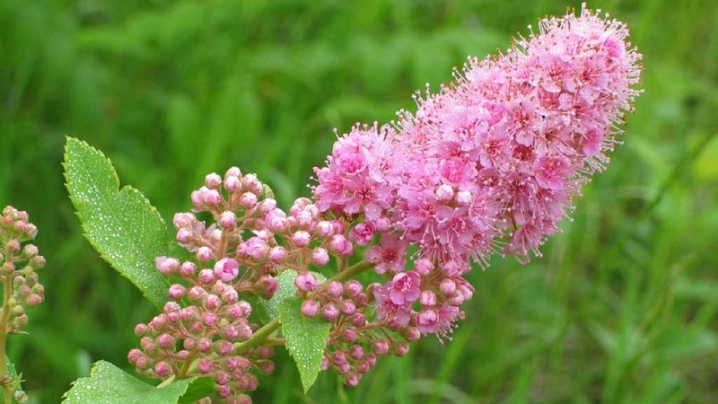
- "Japanese". The most recommended spirea variety for growing in Siberia. Japanese spirea tolerates temperature changes very well and has an increased cold resistance. Hemispherical shrubs have a pinkish leaf plate on top and a bluish one below. The height does not exceed 1.5 meters. In autumn, the foliage of the spirea of this variety takes on a bright orange-red color. Inflorescences have a paniculate-scutellous shape, formed by small pink flowers. The flowering period is about 2 months. It has several varieties.
- Little Princesses - a shrub with a rounded compact crown, reaching 1.5 meters in width and about half a meter in height. The flowering period is in the middle of summer.
- "Golden Princesses" - unlike the Little Princesses, the shrub grows taller and has golden foliage.
- "Shirobana" - compact shrub up to 80 cm in height with lanceolate foliage. It blooms with white or pink flowers in late July or early August.
- "Goldflame" - a variety of spirea, which has a bright yellow foliage color, which gradually becomes more saturated, then greenish, and at the end orange with a copper tint. Inflorescences are pink with a reddish tint.
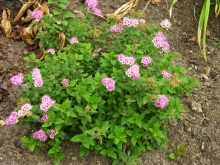
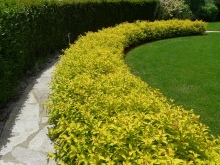
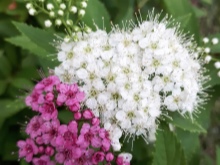
- "Dubravkolistnaya". A very unpretentious variety of spirea, the distribution area is the Far East and Siberia. It differs from other varieties in that it can grow on any soil, including stony ones. The shrub grows low, with greenish small leaves that turn golden in early autumn. The flowering period takes a little less than a month, small creamy flowers are collected in spherical inflorescences.
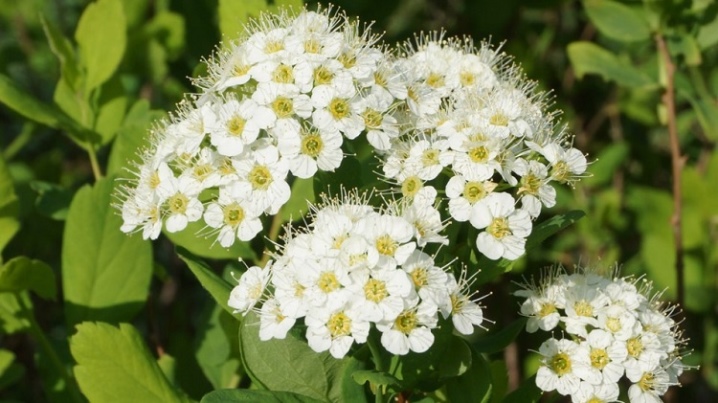
- Billard. Shrub about 2 meters high with lanceolate leaves and small pink flowers, collected in pyramid-like inflorescences. The variety is a hybrid, therefore propagation is possible only with the help of cuttings. It continues to bloom until frost. Differs in high cold resistance and shade tolerance.
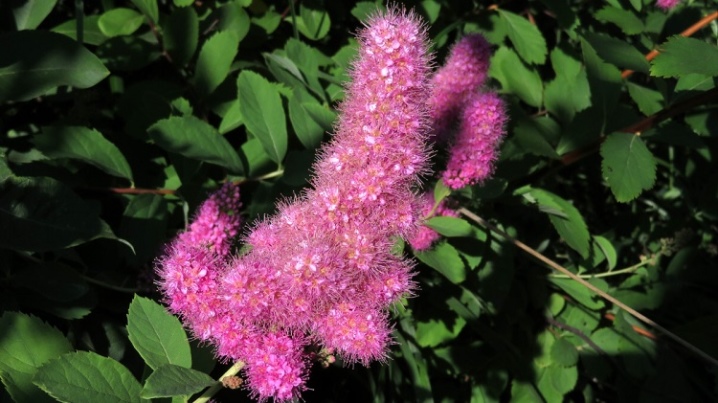
- "Berezolistnaya". It has a similar shape of leaf plates with birch ones. It blooms with white or pale pink flowers, collected in panicle inflorescences. The flowering time is at the beginning of the summer period. The shrub grows about half a meter in height and has good frost resistance.
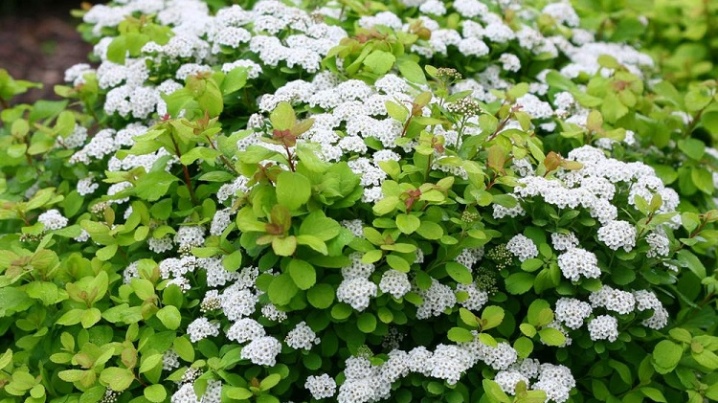
How to plant?
Spirea is a rather unpretentious plant, so planting should not cause significant difficulties. There are several options for shrub propagation: by seeds, cuttings, using layering and separation of bushes. Only non-hybrid plants can be propagated with seeds, as hybrids do not produce seeds. The simplest method is cuttings, since it has a high chance of rooting, and young shoots from cuttings can be planted in their future growing area as early as the next season.
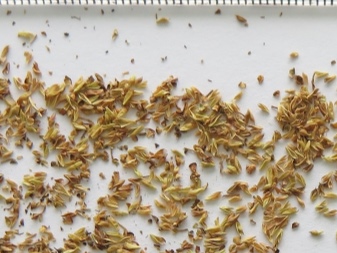
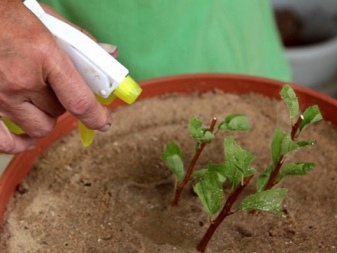
Timing
The timing of planting spirea completely depends on the flowering time of the selected shrub variety. If the variety blooms in the spring, then you need to plant it in the fall. Summer flowering spiraea species are planted in early spring, before the first foliage appears.
In the spring it is better to plant seedlings, and in the fall to plant divided bushes.
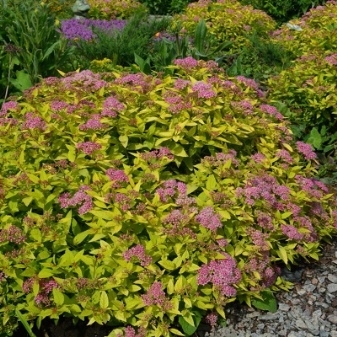

Seat selection
The best option for planting a spirea is a sunny upland, since there can be high humidity in the lowlands, and in the shade it is quite difficult to achieve a lush flowering of the shrub. The spirea has a rather extensive root system, so you should not plant it near fruit-bearing plants, as it often releases layering. The soil is preferable to be loose, good oxygen permeability. In the presence of clay in the soil, it is necessary to arrange a drainage system. If the shrub will be planted in winter, then fertilizer should be applied to the soil in the fall. Both mineral store and organic natural are suitable.


Landing scheme
- The preparation of the holes should be started a few days before planting, so that the earth has time to settle. Pits are dug a little more than half a meter deep, or about 1/3 of the volume of the root system. The distance between the pits must be respected. To grow a hedge, you can leave only 30 cm between the bushes, and for free-standing plants you need at least 70 cm.
- To ensure the drainage effect, the bottom of the pit must be covered with fragments of brick, expanded clay or pieces of rubble.
- To plant a purchased seedling with an open root system, its roots must be lowered for a while in a container of water. If the seedling is in the ground, then it should be well watered.
- Before planting, it is customary for seedlings to trim shoots and shorten unnecessarily long roots a little.
- Part of the soil from the pit is mixed with mineral or organic fertilizer and fills the bottom of the pit.
- The seedling is placed in a hole and covered with the remaining soil. The soil around the bush must be compacted in the form of a small mound.
- Peat or needles for mulching need to be poured over the soil around the seedling.
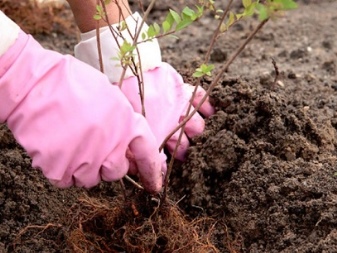

Care
With proper care, small seedlings can grow lush, beautiful shrubs that will brighten up your garden.
Top dressing
In the spring, shortly before flowering, spirea bushes should be fed with nitrogen-containing or organic fertilizer. In the middle of summer, you need to fertilize with mineral fertilizer, and by the end of summer it is better to use fertilizers without nitrogen, with a high content of phosphorus and potassium.
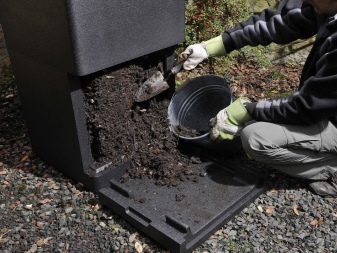
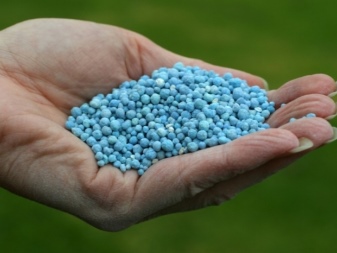
Pruning
The shrub should be pruned every spring. If the variety is from early flowering, then only the apical shoots need to be cut, and if the variety begins to bloom later, then up to 1/3 of the bush can be cut. It is imperative to cut off damaged or dry shoots. After the age of the bush reaches 7 years, you can make anti-aging pruning.
Almost the entire bush is cut, except for a few shoots.
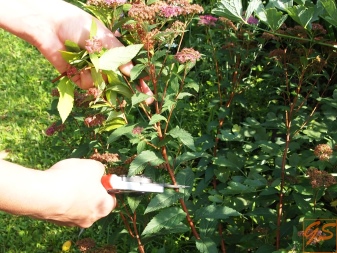
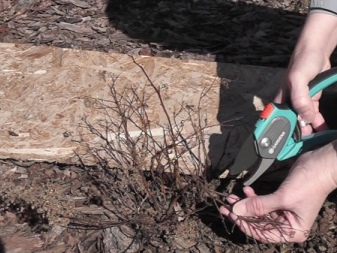
Watering
This plant is quite drought tolerant, but regular watering should be required. About once a month, at least a bucket of water should be poured onto the spirea bush, and if the temperature is high, then watering should be carried out at least once every 2 weeks. A young shrub or seedling planted this year can be especially sensitive to a lack of watering. To prevent the formation of a crust around the trunk, after watering the shrub, you need to loosen the soil with care. Loosening does not need to be carried out deeply, as there is a possibility of damage to the root system.
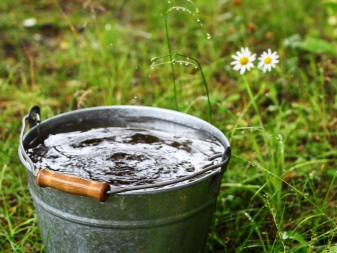
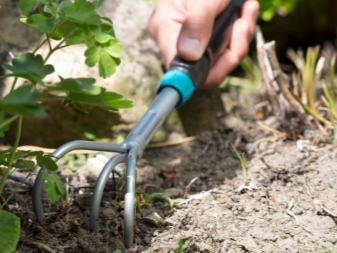
Preparing for winter
Although spiraea is considered a frost-resistant shrub, and most varieties are adapted to the Siberian climate, it is better to cover young, as well as tall shrubs for the winter. First you need to bend the branches and shoots to the ground and fix them at the bottom with staples or ropes. Then the bush is covered with dry leaves, spruce needles or paws, and then you can cover everything with snow. Some gardeners advise treating the bush with a parasite remedy before wintering. Low-growing varieties do not need to be covered, as they tolerate the winter climate quite well under the snow.
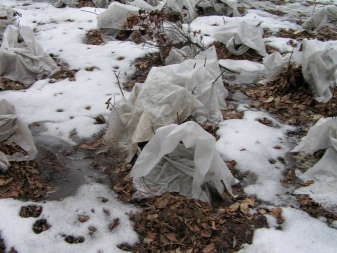

Difficulties in growing
Spirea is an unpretentious shrub, but even experienced gardeners can sometimes have difficulty growing. Sometimes spiraea can be attacked by various parasites and pests. One of the most serious of these is the spider mite. During one growing season of spirea, a tick can change several generations. Whitish specks form on leaf plates infected with spider mites. Soon the leaves of the bush turn yellow, dry and crumble to the ground. Spider mite infestation is most likely during the hottest months of summer. For the treatment of spirea bushes from spider mites, the solutions "Arex", "Metaphos", "Fozalon" or "Fosfomid" are used.
Another dangerous pest for spirea is aphids. It sucks sap from leaf plates, attacks pedicels and young shoots. The greatest peak of aphid activity occurs in June and lasts until the first half of August. To combat aphids use "Pirimor", "Actellik", "Kronefos", "Fozalon".
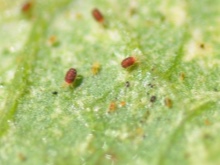

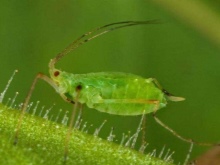
From folk remedies, one can note tobacco and pepper tinctures, treatment with soapy water.
Also, spirea bushes can be attacked by whiteflies, cut leaf rollers and blue meadowsweet sawfly. For the treatment of bushes, it is advisable to use "Fitoverma" and "Decis Profi". As a folk remedy, you can use a solution of laundry soap, copper sulfate, or sprinkle ash on the bush.
In addition to pests, spiraea can undergo a fungal infection. Most often, the plant recovers without treatment, but in rare cases, the fungus can lead to the death of the shrub. For treatment, you need to use antifungal drugs from gardening stores, such as "Fitosporin" or "Fundazol". It does not hurt to treat bushes with them from time to time in order to prevent fungal infections of the plant.


For information on how to grow a spirea from a cutting, see the next video.



































































The comment was sent successfully.